|
| Links |
We parsed the following live from the Web into this page. Such content is managed by its original site and not cached on Discover Life. Please send feedback and corrections directly to the source. See original regarding copyrights and terms of use.
- University of Guelph
- Lucid via Discover Life
|
|
Overview | |
Commonly called twistedwing parasistes, these insects are mostly internal parasites of other insects. Males
differ greatly from females in structure. Males have wide heads with compound eyes on the sides. Males
also have fan shaped antennae. Their forewings have evolved into clublike structures and the hind wings
are membranous and with out venation. Females are without legs, wings, antennae and often eye and
remain in the host their entire lives. The females remain in the host with only their heads protruding.
Males leave the host and find females to mate with. The newly hatched, well-developed larvae leave the
female and fall from the host to the ground or to plants.
Twistedwing parasites enter their insect hosts as larva through joints or sutures when the host itself is still in
its larval stage. From there they undergo what is called "hypermetamorphosis": They molt into another, less
mobile, larval form and feed in the host's body cavity. From there they undergo holometabolous
metamorphosis. Hosts are not usually killed by infection but may be injured. The shape and color of the
abdomen may be changed and the sex organs of the host may be damaged. The male usually causes
more damage to the host than the female. Common hosts are various species from the orders Orthoptera,
Hemiptera, Hymenoptera and Thysanura.
|
|
|
Identification |
- Immatures:
- First instar (triungulin) has legs, high mobility
- Successive instars are legless and grub-like with reduced mouthparts
- Adults:
- Females remain larviform, legless and wingless, partially projecting from host's abdomen.
- Males emerge with adult-like body; Large fan-shaped hind wings; small club-like front wings;
Reduced mandibulate mouthparts; Antennae 4- to 7-segmented; often with lateral branching"--
(N.C. State University
Entomology Dept.)
|
|
|
Phylogeny |
| Taxonomic Category
| Scientific Name
| Common Name
|
| Phylum
| Arthropoda
| Arthropods
|
| Class
| Insecta
| Insects
|
| Order
| Strepsiptera
| Twisted-winged parasites
|
|
|
|
Photographs |
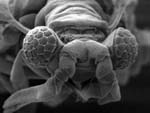 |
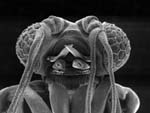 |
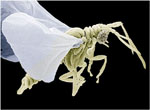 |
[Species: Xenos ssp.]
Photo copyright Birgit Ehmer |
[Species: Xenos. ssp.]
Photo copyright Birgit Ehmer
|
[Species: Elenchus tenuicornis ]
Photo copyright Hans Pohl |
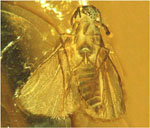 |
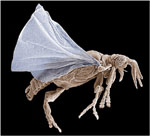 |
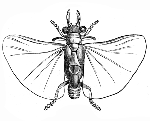 |
[Species: Mengea tertiaria ]
Photo copyright Hans Pohl |
[Species: Xenos vesparum ]
Photo copyright Hans Pohl |
[Family: Stylopidae ]
Photo copyright Dept. of Entomology: Penn State |
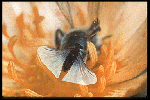 |
 |
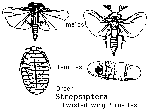 |
[Order: Strepsiptera ]
Photo copyright E. R. Day |
[Order: Strepsiptera ]
Photo copyright Hans Pohl |
[Order: Strepsiptera ]
Photo copyright Rick Redak |
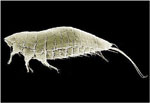 |
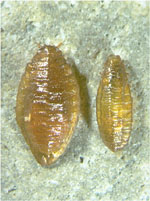 |
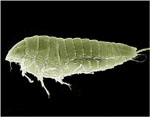 |
[Species: Mengenilla chobauti]
Photo copyright Hans Pohl |
[Species: Eoxenos laboulbenei]
Photo copyright Hans Pohl |
[Species: Stichotrema dallatorreanum]
Photo copyright Hans Pohl |
|
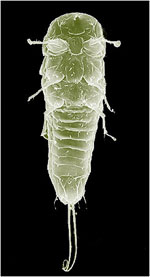 |
|
|
[Species:Stichotrema dallatorreanum]
Photo copyright Hans Pohl |
|
|
|
|
Geographic distribution |
|
North America
|
Worldwide
|
| Number of Families |
4 |
8 |
| Number of Species |
109 |
532 |
|
|
|
Natural history | |
Most Strepsiptera (also known as twisted-wing parasites) live as internal parasites of bees,
wasps, grasshoppers, leafhoppers, and other members of the order Hemiptera. Only a
few species that parasitize bristletails (Archeognatha) are known to be free-living in the adult
stage.
Strepsiptera share so many characteristics with beetles that some entomologists classify
them as a superfamily of Coleoptera. In fact, Strepsiptera and certain parasitic beetles (in
the families Meloidae and Rhipiphoridae) are among the very few insects that undergo
hypermetamorphosis, an unusual type of holometabolous development in which the larvae
change body form as they mature. Upon emerging from their mother's body, the young
larvae, called triunguloids, have six legs and crawl around in search of a suitable host. In
species that parasitize bees or wasps, a triunguloid usually climbs to the top of a flower and
waits for a pollinator. When a host arrives, the larva jumps aboard, burrows into its body,
and quickly molts into a second stage that has no distinct head, legs, antennae or other
insect-like features. These larvae grow and continue to molt inside the host's body cavity,
assimilating nutrients from the blood and non-vital tissues. After pupating in the host,
winged males emerge and fly in search of mates. An adult female remains inside her host,
managing to attract and mate with a male while only a small portion of her body protrudes
from the host's abdomen. Embryos develop within the female's body, and a new
generation of triunguloid larvae begin their life cycle by escaping through a brood passage
on the underside of her body.
Adult male Strepsiptera are strange-looking insects. The head is small, with protruding
compound eyes that look like tiny raspberries. The antennae are multi-segmented and
have up to three branches. Front wings are reduced to small, club-like structures; hind
wings are very large and fan-shaped."-- (N.C. State University Entomology Dept.)
|
|
|
Links to other sites | |
|
|
|
Acknowledgements | |
Aeneas Munane, Biology Major, University of Georgia, Athens.
Thanks to Sabina Gupta, Denise Lim, and Dr. John Pickering for technical and web support in developing this page.
|
|
| Supported by | |
|
Following modified from University of Guelph
|
Top | See original
| &pull 20q v5.145 20180528: Error 301 Moved Permanently http://www.uoguelph.ca/debu/STEVEweb/html/Strepsiptera.html |
ERROR -- Need to remove recursive link: http://www.discoverlife.org/nh/id/lucid/Insect_orders/html/Strepsiptera.html Lucid via Discover Life
Updated: 2024-04-24 08:17:10 gmt
|